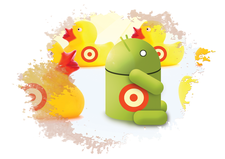Exploring the Flask web framework in Python
Hip Flask

The Flask micro framework emerged from an April Fool's prank, but this simple and easy web development aid is no joke.
Developers who are looking for a Python web framework often turn to the popular Django framework [1], but Django isn't the best choice for every situation. For instance, developers occasionally face tasks that are very difficult to solve with Django's object relational mapper (ORM) or that require additional applications or other frameworks. In some cases, the versatility of Django leads to a complexity that simply isn't needed for a quick and simple project. When less is actually more, a micro web framework such as Flask [2] is often a better option.
This article demonstrates the Flask web framework by putting it to work on a real-world web application: a handy little brainstorming tool known as Geistesblitze. The word Geistesblitze is German for brainstorms or flashes of genius. The tool consists of a web application with graphical Web UI for quickly capturing and associating ideas. This simple example will introduce you to the most important and interesting aspects of Flask. The complete code is available under a BSD license on GitHub [3].
April Fool!
In 2010, the Denied [4] micro web framework popped up on the web for the first time. Python developer Armin Ronacher published it as April Fool's day joke; he wanted to poke fun at the business model of various micro web frameworks that were popular at the time. He bundled all the code into a single file called deny.py and posted a badly programmed web page (Figure 1) with fake quotes. He also shot a movie with a Dutch friend posing as the French developer of Denied [5].
[...]
Buy this article as PDF
(incl. VAT)
Buy Linux Magazine
Subscribe to our Linux Newsletters
Find Linux and Open Source Jobs
Subscribe to our ADMIN Newsletters
Support Our Work
Linux Magazine content is made possible with support from readers like you. Please consider contributing when you’ve found an article to be beneficial.

News
-
Zorin OS 18 Hits over a Million Downloads
If you doubt Linux isn't gaining popularity, you only have to look at Zorin OS's download numbers.
-
TUXEDO Computers Scraps Snapdragon X1E-Based Laptop
Due to issues with a Snapdragon CPU, TUXEDO Computers has cancelled its plans to release a laptop based on this elite hardware.
-
Debian Unleashes Debian Libre Live
Debian Libre Live keeps your machine free of proprietary software.
-
Valve Announces Pending Release of Steam Machine
Shout it to the heavens: Steam Machine, powered by Linux, is set to arrive in 2026.
-
Happy Birthday, ADMIN Magazine!
ADMIN is celebrating its 15th anniversary with issue #90.
-
Another Linux Malware Discovered
Russian hackers use Hyper-V to hide malware within Linux virtual machines.
-
TUXEDO Computers Announces a New InfinityBook
TUXEDO Computers is at it again with a new InfinityBook that will meet your professional and gaming needs.
-
SUSE Dives into the Agentic AI Pool
SUSE becomes the first open source company to adopt agentic AI with SUSE Enterprise Linux 16.
-
Linux Now Runs Most Windows Games
The latest data shows that nearly 90 percent of Windows games can be played on Linux.
-
Fedora 43 Has Finally Landed
The Fedora Linux developers have announced their latest release, Fedora 43.

